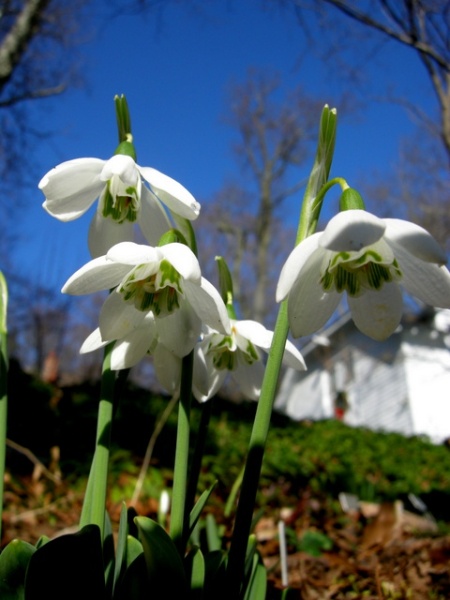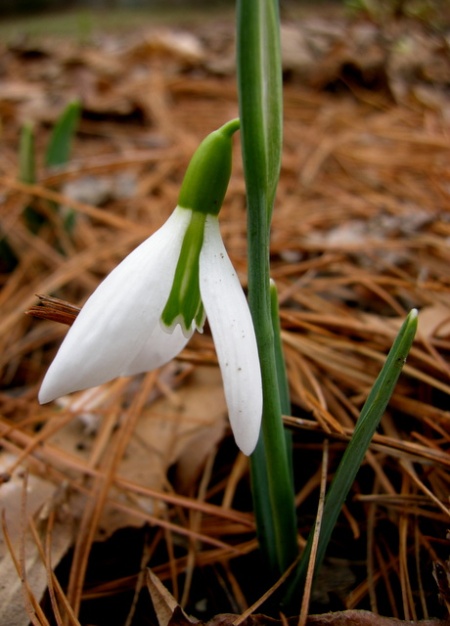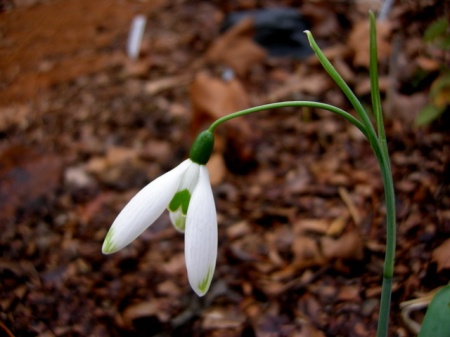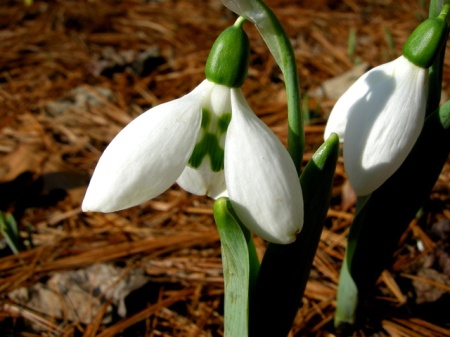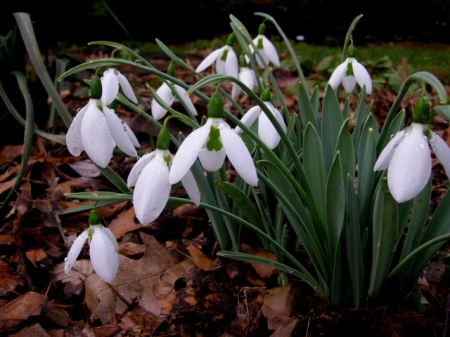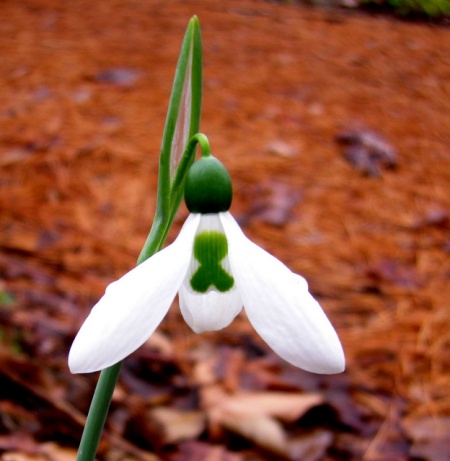 The classic snowdrop ‘Atkinsii’ glowing on a sunny day in February at Carolyn’s Shade Gardens.
The classic snowdrop ‘Atkinsii’ glowing on a sunny day in February at Carolyn’s Shade Gardens.
Our current snowdrop catalogue is on line here.
Highlighted in this post are five classic snowdrops that will be available in our 2020 Snowdrop Catalogue. These snowdrops are still treasured by snowdrop enthusiasts everywhere even though they are more than 100 years old, and they all embody what attracts me to snowdrops.
People often ask me why I love snowdrops. There are many reasons. Originally, it was their bloom time: who can resist a flower looking like ‘Atkinsii’ in the above photograph in early February, my least favorite time of year?
Nursery News: Carolyn’s Shade Gardens is a retail nursery located in Bryn Mawr, PA, specializing in showy, colorful, and unusual plants for shade. The only plants that we ship are snowdrops within the US. For catalogues and announcements of local events, please send your full name, mailing address, and cell number to carolyn@carolynsshadegardens.com and indicate whether you are interested in snowdrops. Click here to get to the home page of our website for catalogues and information about our nursery and to subscribe to our blog.
.
Snowdrops are also quite beautiful and elegant, especially when they are tall and stately with large flowers like ‘Atkinsii’ and several of the other classic snowdrops shown below.
. Snowdrops describes ‘Atkinsii’ as having “elegant elongated flowers that suggest the drop-pearl earrings of Elizabeth I”—a true English classic. The reference is to Snowdrops: A Monograph of Cultivated Galanthus by Matt Bishop, Aaron Davis, and John Grimshaw (Griffin Press 2006), which contains a lot of the information in this post.
Snowdrops describes ‘Atkinsii’ as having “elegant elongated flowers that suggest the drop-pearl earrings of Elizabeth I”—a true English classic. The reference is to Snowdrops: A Monograph of Cultivated Galanthus by Matt Bishop, Aaron Davis, and John Grimshaw (Griffin Press 2006), which contains a lot of the information in this post.
.
 This photo illustrates the size difference between ‘Atkinsii’ in the back and the double common snowdrop in the front.
This photo illustrates the size difference between ‘Atkinsii’ in the back and the double common snowdrop in the front.
Third, snowdrops are also the most reliable winter-blooming plants in my garden and are very easy to grow. And, among the many forms I grow, the tried-and-true classics multiply the fastest to form eye-catching swathes of blooms, which is what I am after. I am not a collector who wants to have one of everything! It would be impossible now anyway as experts estimate that there are over 2,500 snowdrop cultivars in existence.
.
 ‘Atkinsii’ is a great multiplier. Here it fills a hillside at Painswick Rococo Garden in Gloucestershire, England. For more on ‘Atkinsii’ at Painswick, read my blog post here. It has received the prestigious Award of Garden Merit from the Royal Horticultural Society (“RHS AGM) as one of the most suitable snowdrops for the garden. ‘Atkinsii’ was selected in the 1860s by a prominent 19th century plantsman, James Atkins, who retired to the village of Painswick. It was named after him in 1889 by James Allen, one of the most important snowdrop experts of all time.
‘Atkinsii’ is a great multiplier. Here it fills a hillside at Painswick Rococo Garden in Gloucestershire, England. For more on ‘Atkinsii’ at Painswick, read my blog post here. It has received the prestigious Award of Garden Merit from the Royal Horticultural Society (“RHS AGM) as one of the most suitable snowdrops for the garden. ‘Atkinsii’ was selected in the 1860s by a prominent 19th century plantsman, James Atkins, who retired to the village of Painswick. It was named after him in 1889 by James Allen, one of the most important snowdrop experts of all time.
Fourth, snowdrops are plants with colorful histories, which I find fascinating. The stories of the horticulturists who selected the earliest snowdrop cultivars like ‘Atkinsii’ are well-documented in The Galanthophiles: 100 Years of Snowdrop Devotees by Jane Kilpatrick and Jennifer Harmer (Orphans Publishing 2018) from which I extracted many of the historical facts in this post. Snowdrops are also found in historic places like Colesbourne Park, (in the photo below) the estate of the famous Victorian plant explorer and snowdrop lover Henry John Elwes (1846-1922), who received his original stock of ‘S. Arnott’ from Samuel Arnott.
.
 Thousands of another classic snowdrop ‘S. Arnott’ bloom every year at Colesbourne Park, the premier snowdrop destination in England. Snowdrops describes ‘S. Arnott’ as “a first-class garden plant with an unquestionable constitution, admired by everyone….[a] classic snowdrop.” This is the snowdrop that collectors repeatedly state that they would choose if they were limited to one—the so-called “desert island snowdrop”. It is named for an early galanthophile, Samuel Arnott (1852-1930). ‘S. Arnott’ has also received an RHS AGM, one of only 28 snowdrops to receive this honor.
Thousands of another classic snowdrop ‘S. Arnott’ bloom every year at Colesbourne Park, the premier snowdrop destination in England. Snowdrops describes ‘S. Arnott’ as “a first-class garden plant with an unquestionable constitution, admired by everyone….[a] classic snowdrop.” This is the snowdrop that collectors repeatedly state that they would choose if they were limited to one—the so-called “desert island snowdrop”. It is named for an early galanthophile, Samuel Arnott (1852-1930). ‘S. Arnott’ has also received an RHS AGM, one of only 28 snowdrops to receive this honor.
And, finally, I have met some of my favorite people while visiting snowdrops.
.
 Our friends Sir Henry and Lady Carolyn Elwes maintain Colesbourne Park as a spectacular snowdrop destination. Here, Sir Henry Elwes talks about snowdrops at Colesbourne Park, standing in a patch of ‘S. Arnott’.
Our friends Sir Henry and Lady Carolyn Elwes maintain Colesbourne Park as a spectacular snowdrop destination. Here, Sir Henry Elwes talks about snowdrops at Colesbourne Park, standing in a patch of ‘S. Arnott’.
.
 Alan Street in a border of ‘S. Arnott’ during our walk around Avon Bulbs. He is the only person I know who gets more excited about snowdrops than I do.
Alan Street in a border of ‘S. Arnott’ during our walk around Avon Bulbs. He is the only person I know who gets more excited about snowdrops than I do.
. ‘S. Arnott’ in the lovely private garden “Welshway” of Hilary and Hugh Purkess in Gloucestershire, where we received a wonderful garden tour and some hot tea with delicious cake on a freezing day in February.
‘S. Arnott’ in the lovely private garden “Welshway” of Hilary and Hugh Purkess in Gloucestershire, where we received a wonderful garden tour and some hot tea with delicious cake on a freezing day in February.
Despite the fact that all these snowdrops have been around for over a hundred years, they are still treasured by galanthophiles and grown in every serious enthusiast’s garden because they are such good plants.
. Although there are a plethora of new snowdrop cultivars, Avon Bulbs still chose to feature ‘S. Arnott’ in its award-winning display at the Royal Horticultural Society Spring Show.
Although there are a plethora of new snowdrop cultivars, Avon Bulbs still chose to feature ‘S. Arnott’ in its award-winning display at the Royal Horticultural Society Spring Show.
Here are three more classic snowdrops I think you will love:
. ‘Merlin’ is a another beautiful classic snowdrop discovered in 1891 by Victorian plantsman James Allen of Shepton Mallet in Somerset.
‘Merlin’ is a another beautiful classic snowdrop discovered in 1891 by Victorian plantsman James Allen of Shepton Mallet in Somerset.
.
 ‘Merlin’s’ almost solid green inner segments are quite striking shown here at Carolyn’s Shade Gardens. It has been awarded an RHS AGM as an excellent snowdrop for the garden.
‘Merlin’s’ almost solid green inner segments are quite striking shown here at Carolyn’s Shade Gardens. It has been awarded an RHS AGM as an excellent snowdrop for the garden.
.
 ‘Hill Poë’ is a beautiful and vigorous classic snowdrop, shown here at Carolyn’s Shade Gardens. It was discovered by James Hill Poë in his garden at Riverston, County Tipperary, Ireland, in a patch of Galanthus plicatus, sometimes called the Crimean snowdrop. In March of 1917, he wrote to an RHS publication that the G. plicatus came to him from a family who received them from an officer serving in the Crimean War (1853-1856). Many soldiers sent or brought home snowdrops from the Crimea, a testament to the irresistible attraction of snowdrops.
‘Hill Poë’ is a beautiful and vigorous classic snowdrop, shown here at Carolyn’s Shade Gardens. It was discovered by James Hill Poë in his garden at Riverston, County Tipperary, Ireland, in a patch of Galanthus plicatus, sometimes called the Crimean snowdrop. In March of 1917, he wrote to an RHS publication that the G. plicatus came to him from a family who received them from an officer serving in the Crimean War (1853-1856). Many soldiers sent or brought home snowdrops from the Crimea, a testament to the irresistible attraction of snowdrops.
.
 ‘Hill Poë’ is double and has five outer segments.
‘Hill Poë’ is double and has five outer segments.
.
 ‘Hill Poë’s’ inner segments are very regular and full.
‘Hill Poë’s’ inner segments are very regular and full.
.
 ‘Hill Poë’ at Evenley Wood Garden in Northamptonshire, England.
‘Hill Poë’ at Evenley Wood Garden in Northamptonshire, England.
.
 ‘Scharlockii’ is another classic snowdrop, which, though not as tall, is even more vigorous than the others profiled in this post, shown here growing at Carolyn’s Shade Gardens. It is identified by the lovely green markings on its outer segments and even more so by the “rabbit ears” overarching each flower. They appear when the spathe (flower covering) splits to drop the flower bud and then elongates into two leafy ears.
‘Scharlockii’ is another classic snowdrop, which, though not as tall, is even more vigorous than the others profiled in this post, shown here growing at Carolyn’s Shade Gardens. It is identified by the lovely green markings on its outer segments and even more so by the “rabbit ears” overarching each flower. They appear when the spathe (flower covering) splits to drop the flower bud and then elongates into two leafy ears.
.
 ‘Scharlockii’ is a selection from Galanthus nivalis, the common snowdrop, made by Julius Scharlock in 1868 near Frankfurt, Germany.
‘Scharlockii’ is a selection from Galanthus nivalis, the common snowdrop, made by Julius Scharlock in 1868 near Frankfurt, Germany.
.
 ‘Scharlockii’ in the copse at Avon Bulbs in Somerset, England.
‘Scharlockii’ in the copse at Avon Bulbs in Somerset, England.
It is difficult to imagine now with the multitude of named snowdrops available, that at a seminal RHS snowdrop conference in 1891, there were only 42 cultivars in existence. All five of the snowdrops in this post existed then and have persisted as desirable plants to this day despite the competition. In 2001, when Matt Bishop’s book (referenced above) was published as an exhaustive reference, there were approximately 500 snowdrops included. Earlier in 2019, A Gardener’s Guide to Snowdrops: Second Edition by Freda Cox (Crowood Press) was published and provides beautiful drawings, descriptions, and brief histories for 2,400 cultivars. It takes a lot to stand out in that crowd.
Carolyn
.
Note: Every word that appears in orange on my blog is a link that you can click for more information. If you want to return to my blog’s homepage to access the sidebar information (catalogues, previous articles, etc.) or to subscribe to my blog, just click here.










































